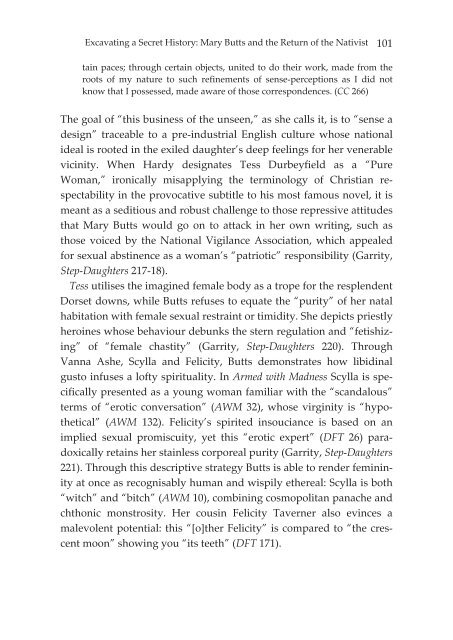This Article as pdf - Connotations
This Article as pdf - Connotations
This Article as pdf - Connotations
You also want an ePaper? Increase the reach of your titles
YUMPU automatically turns print PDFs into web optimized ePapers that Google loves.
Excavating a Secret History: Mary Butts and the Return of the Nativist<br />
101<br />
tain paces; through certain objects, united to do their work, made from the<br />
roots of my nature to such refinements of sense-perceptions <strong>as</strong> I did not<br />
know that I possessed, made aware of those correspondences. (CC 266)<br />
The goal of “this business of the unseen,” <strong>as</strong> she calls it, is to “sense a<br />
design” traceable to a pre-industrial English culture whose national<br />
ideal is rooted in the exiled daughter’s deep feelings for her venerable<br />
vicinity. When Hardy designates Tess Durbeyfield <strong>as</strong> a “Pure<br />
Woman,” ironically misapplying the terminology of Christian respectability<br />
in the provocative subtitle to his most famous novel, it is<br />
meant <strong>as</strong> a seditious and robust challenge to those repressive attitudes<br />
that Mary Butts would go on to attack in her own writing, such <strong>as</strong><br />
those voiced by the National Vigilance Association, which appealed<br />
for sexual abstinence <strong>as</strong> a woman’s “patriotic” responsibility (Garrity,<br />
Step-Daughters 217-18).<br />
Tess utilises the imagined female body <strong>as</strong> a trope for the resplendent<br />
Dorset downs, while Butts refuses to equate the “purity” of her natal<br />
habitation with female sexual restraint or timidity. She depicts priestly<br />
heroines whose behaviour debunks the stern regulation and “fetishizing”<br />
of “female ch<strong>as</strong>tity” (Garrity, Step-Daughters 220). Through<br />
Vanna Ashe, Scylla and Felicity, Butts demonstrates how libidinal<br />
gusto infuses a lofty spirituality. In Armed with Madness Scylla is specifically<br />
presented <strong>as</strong> a young woman familiar with the “scandalous”<br />
terms of “erotic conversation” (AWM 32), whose virginity is “hypothetical”<br />
(AWM 132). Felicity’s spirited insouciance is b<strong>as</strong>ed on an<br />
implied sexual promiscuity, yet this “erotic expert” (DFT 26) paradoxically<br />
retains her stainless corporeal purity (Garrity, Step-Daughters<br />
221). Through this descriptive strategy Butts is able to render femininity<br />
at once <strong>as</strong> recognisably human and wispily ethereal: Scylla is both<br />
“witch” and “bitch” (AWM 10), combining cosmopolitan panache and<br />
chthonic monstrosity. Her cousin Felicity Taverner also evinces a<br />
malevolent potential: this “[o]ther Felicity” is compared to “the crescent<br />
moon” showing you “its teeth” (DFT 171).
















